A Variable Step-Size Exponentially Fitted Explicit Hybrid Method for Solving Oscillatory Problems
Abstract
An exponentially fitted explicit hybrid method for solving oscillatory problems is obtained. This method has four stages. The first three stages of the method integrate exactly differential systems whose solutions can be expressed as linear combinations of {1, x, exp(μx), exp(−μx)}, μ ∈ C, while the last stage of this method integrates exactly systems whose solutions are linear combinations of {1, x, x2, x3, x4, exp(μx), exp(−μx)}. This method is implemented in variable step-size code basing on an embedding approach. The stability analysis is given. Numerical experiments that have been carried out show the efficiency of our method.
1. Introduction
This paper concerns derivation of a new method for the numerical integration of (1.1) with oscillatory solution through the usage of an exponential-fitting technique proposed by Vanden Berghe and Van Daele [4]. The coefficients of the new method depend on the product of frequency and step size, thus the method can only be applied when a good estimate of the dominant frequency of the solution is known in advance. The exponential-fitting technique is generally described in the context of linear multistep methods as follows.
Step 1. Find the maximal M such that L integrates exactly the set of power functions {1, x, x2, …, xM−1} and that the resulting coefficients have the same value as those of a classical method. The classical method is the method with constant coefficients.
Step 2. Consider this set of functions
Considering each formula stage of a hybrid method as a linear multistep method with nonequidistant grid points; we derive our exponentially fitted hybrid method. This approach has also been employed by Simos and Vigo-Aguiar [1] and D’Ambrosio et al. [5] in their derivation of exponential-fitting methods.
2. Embedded Pairs of Hybrid Methods
(i) if tol/div < LTE < div · tol, then hn+1 = hn,
(ii) if LTE ≤ tol/div , then hn+1 = 2hn,
(iii) if LTE ≥ div · tol, then hn+1 = (1/2)hn and repeat the step,
where, from numerical experiments, div is chosen to be 217. We do not allow step-size change after each step because it would contribute to unnecessary rounding errors. If the step is acceptable (i.e., tol/div < LTE < div · tol and LTE ≤ tol/div), then we adopt the widely used of performing local extrapolation: although the LTE is the error estimation for the lower-order formula, the solutions obtained by using the higher-order formula are actually accepted at each point.
3. Construction of Hybrid Methods
3.1. The Sixth-Order Hybrid Method of Franco
In this section, we consider the sixth-order hybrid method which is zero dissipative and dispersive of order six derived in [6]. The interval of periodicity of the method is (0, 2.75). In order for the method to be implemented in variable step-size code as described in Section 2, we derive a three-stage fourth-order explicit hybrid method. Order conditions for the fourth-order hybrid methods with s = 4 as given in [9] are listed as follows.
3.2. Variable Step-Size Exponentially Fitted Explicit Hybrid Method
Step 1. Consider the linear operator L that associated with (3.6). Solving equations obtained by assuming that c3 = 1/5 and imposing L to integrate exactly x2 and x3, we obtain a31 = 4/125 and a32 = 11/125 which is the same value as the coefficients of EHM6(4) method. This means that M = 4. Choosing K = 1, P = 0 gives us {1, x, e±μx}. Setting c3 = 1/5 and imposing L to integrate exactly e±μx leads the following equations:
Step 2. Consider the linear operator L that associated with (3.7). Solving equations obtained by assuming that c3 = 1/5, c4 = 7/10, a41 = 119/2000 and imposing L to integrate exactly x2 and x3, we obtain a42 = 1071/2000 and a43 = 0 which are of the same value as the coefficients of EHM6(4) method. This means that M = 4. Choosing K = 1, P = 0 gives us {1, x, e±μx}. Setting c3 = 1/5, c4 = 7/10, a41 = 119/2000, and L[h, a]e±μx = 0, we get the following equations:
Step 3. Consider the linear operator L that associated with (3.8). Solving equations obtained by assuming that c3 = 1/5, c4 = 7/10, c5 = −1/2, a51 = −11/204, a52 = −7/144 and imposing L to integrate exactly x2 and x3, we obtain a53 = −7/144 and a54 = 4/153 which are of the same value as the coefficients of EHM6(4) method. This means that M = 4. Choosing K = 1 and P = 0 gives us {1, x, e±μx}. Setting c3 = 1/5, c4 = 7/10, c5 = −1/2, a51 = −11/204, a52 = −7/144, and L[h, a]e±μx = 0 leads to the following equations:
Step 4. The linear operator associating with (3.9) is given as
Step 5. Consider
4. Stability
Definition 4.1. For exponentially fitted hybrid methods corresponding to the characteristic equation (4.5) and satisfying P(H2, z) = 1, a region of stability Ω is a region of the H-z plane throughout which |S(H2, z)| < 2. Any closed curve defined by |S(H2, z)| = 2 is a stability boundary.
Definition 4.2. For exponentially fitted hybrid methods corresponding to the characteristic equation (4.5) and satisfying |P(H2, z)| < 1, a region of stability Ω is a region of the H-z plane such that, for every (H, z) ∈ Ω,
In Figure 1, we illustrate the stability region of the exponentially fitted method which is based on the higher-order formula of EHM6(4) method whereas, in Figure 2, we show the stability region of the exponentially fitted method which is based on the lower-order formula of EHM6(4) method. From Figures 1 and 2, it is observed that the stability regions get smaller as H increases.
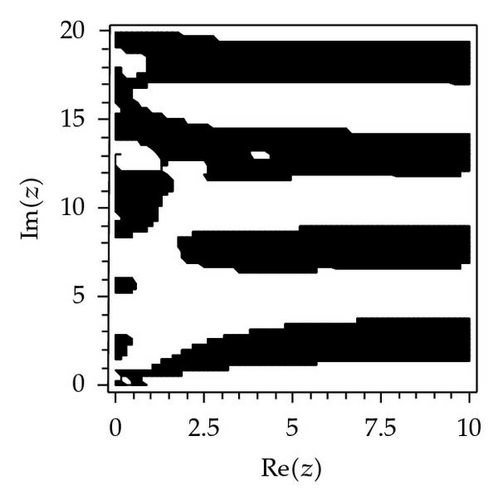
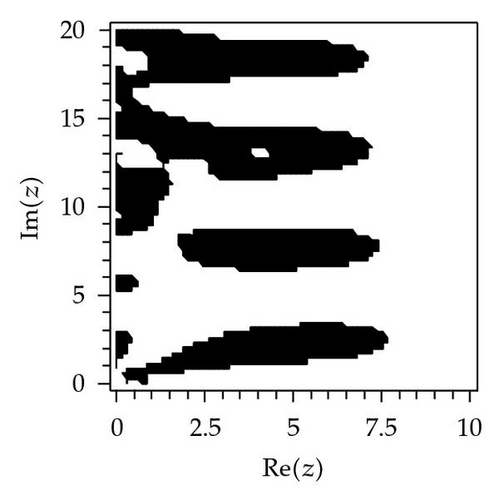
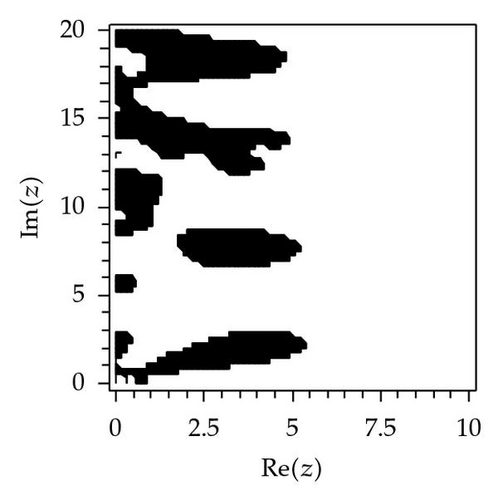
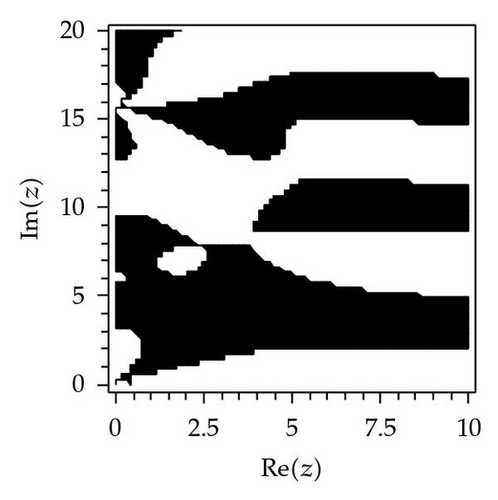

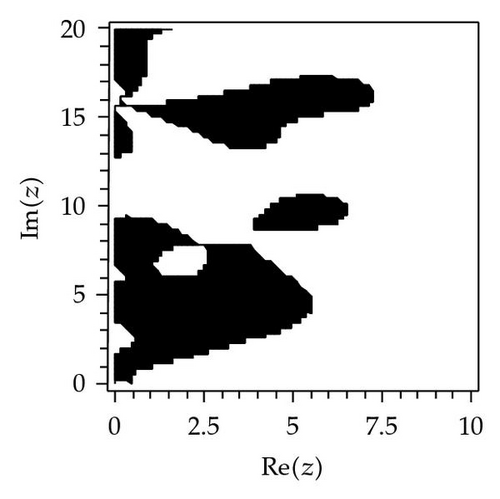
5. Numerical Experiments
- (i)
EEHM6(4): Variable step-size exponentially fitted explicit hybrid method derived in this paper. This method requires four function evaluations at each step.
- (ii)
EHM6(4): Embedded explicit hybrid method 6(4) pair derived in this paper. This method requires four function evaluations at each step.
- (iii)
FRKN4(3): Modified embedded explicit RKN 4(3) pair proposed by Van de Vyver [10]. This method requires three function evaluations at each step.
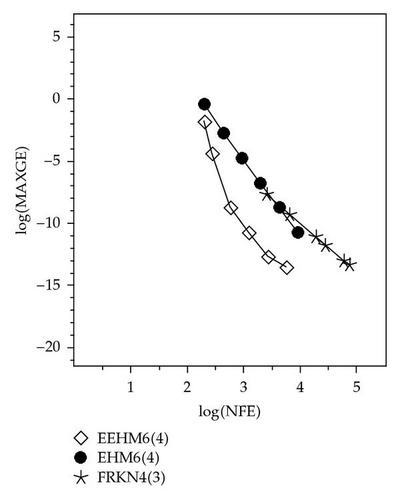
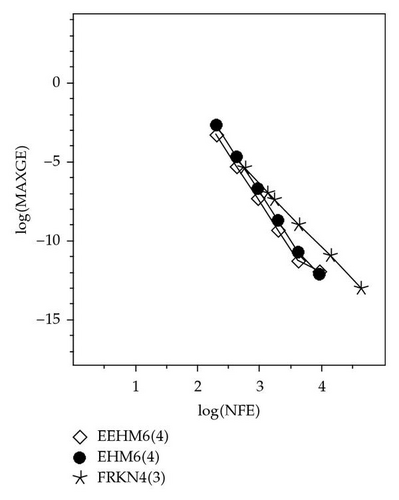
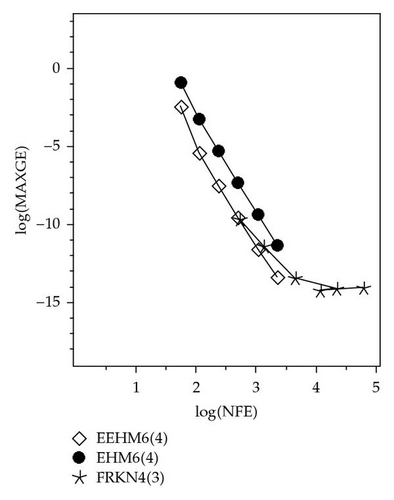
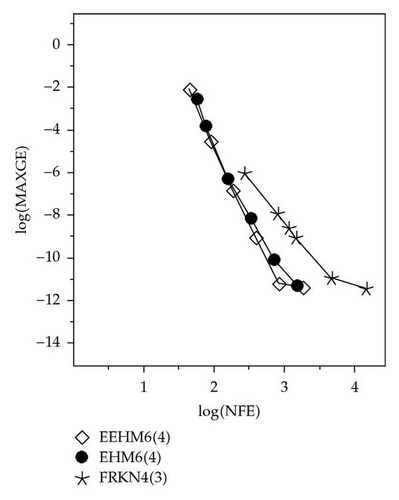
Problem 1 (perturbed system). Source: Franco [11]:
Problem 2 (linear oscillatory problem). Source: Franco [6]:
Problem 3 (perturbed system). Source: Hans Van de Vyver [10]:
Problem 4 (the undamped Duffing equation). Source: Van de Vyver [10]:
From Figures 3–5, it is obvious that EEHM6(4) performs more efficiently than EHM6(4) and FRKN4(3) codes for solving Problems 1–3. For Problem 4, EEHM6(4) is as efficient as EHM6(4) code.
6. Conclusions
The embedding approach for hybrid methods has been devised by adopting the embedding concept in RKN methods. By using this embedding approach, we present Franco’s sixth-order explicit hybrid method for variable step-size code, denoted as EHM6(4) method. Based on EHM6(4) method, the new variable step-size exponentially fitted hybrid method has been developed and it is denoted as EEHM6(4) method. The numerical results show that EEHM6(4) method is efficient for the numerical solution of oscillatory problems. Furthermore, EEHM6(4) method is preferable to handle perturbed oscillators.




